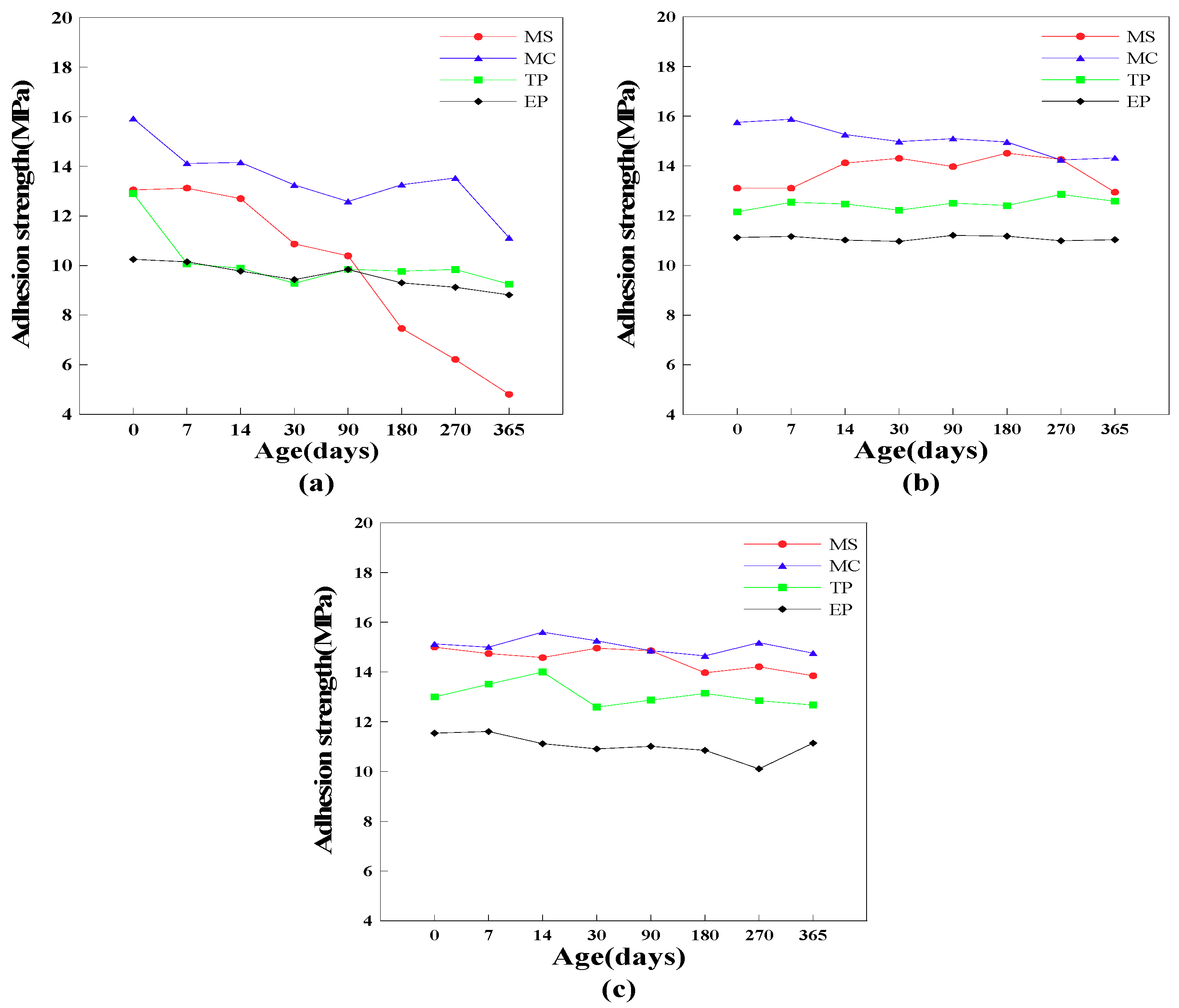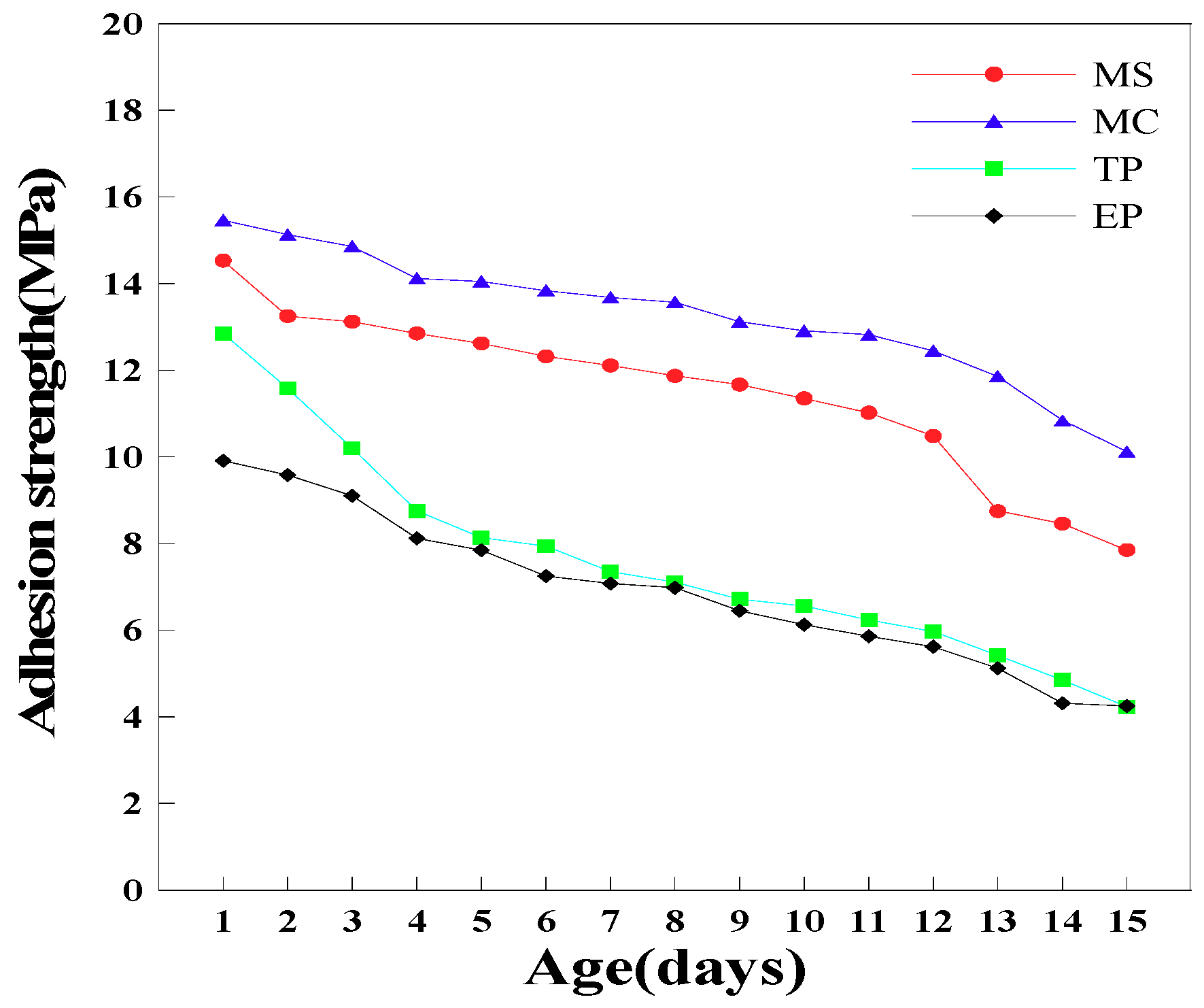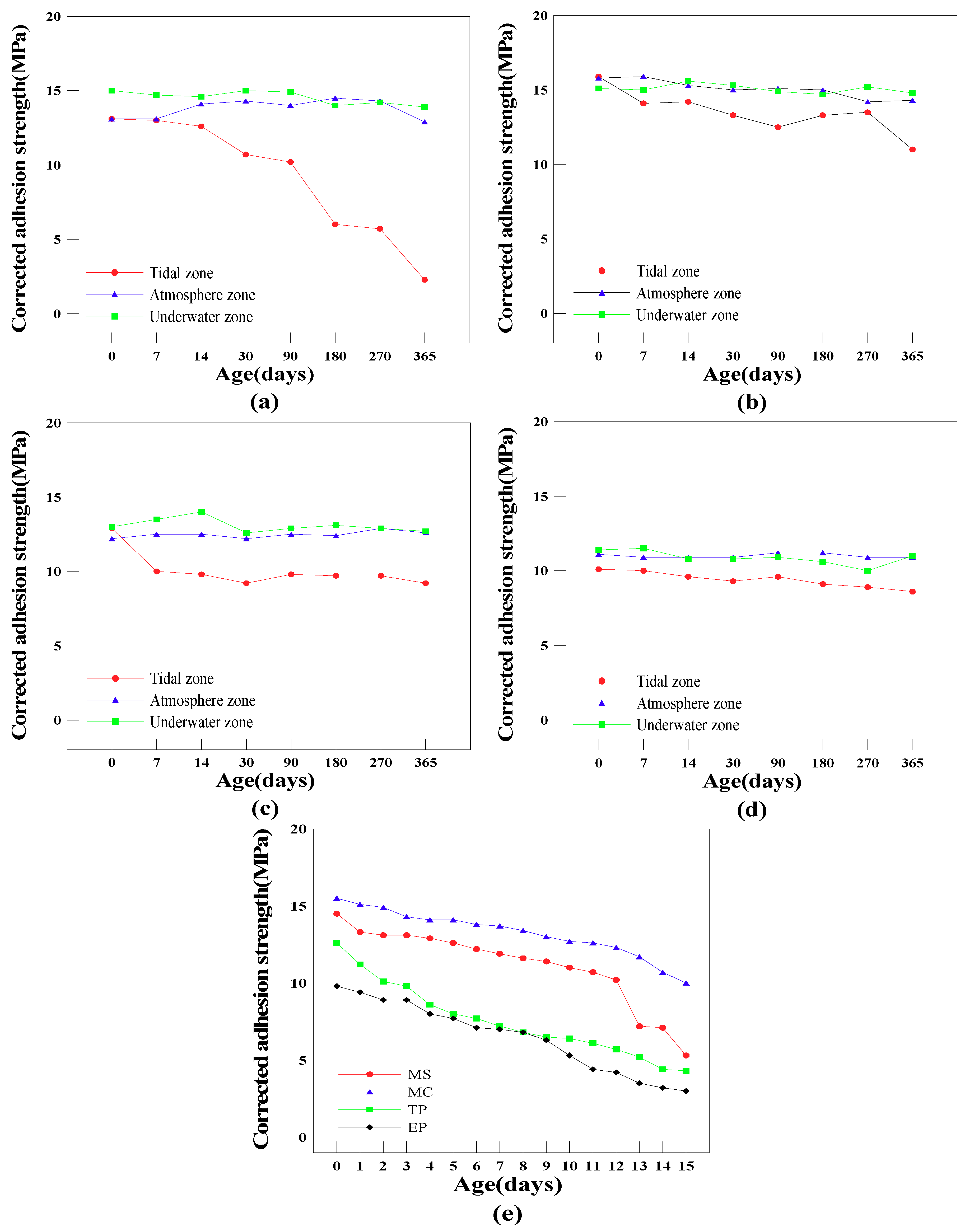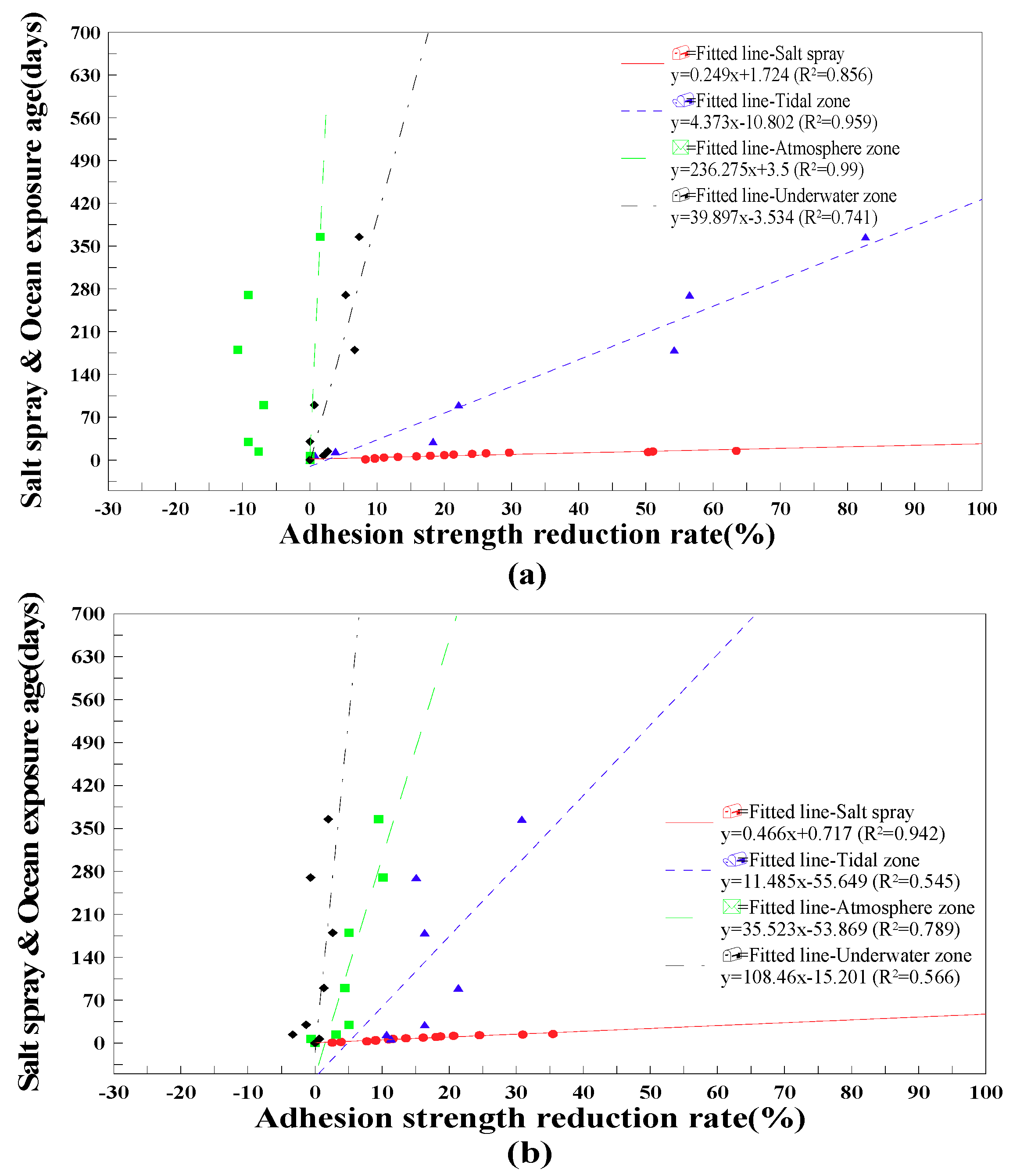Assessment of Anti-Corrosion Performances of Coating Systems for Corrosion Prevention of Offshore Wind Power Steel Structures
Abstract
:1. Introduction
2. Test Sample Fabrication
3. Assessment Method
3.1. Anti-Corrosion Performance Assessment
3.2. Sea Exposure and Indoor Tests
4. Results and Discussion
4.1. Adhesion Strength after Exposure to the Marine Environment
4.2. Adhesion Strength after Salt Spray Test
4.3. Fracture Type after the Adhesion Strength Test
4.4. Correction of Adhesion Strength
4.5. Corrosion Rate Comparison between the Indoor Corrosion Acceleration Test and Sea Exposure Test
5. Conclusions
- (1)
- When fracture occurred from the coating layer beneath the top coating of the coating system, the adhesion strength deteriorated depending on the fracture type. When fracture occurred between the surface and the 1st coating, the adhesion strength significantly decreased compared to that before exposure.
- (2)
- The corrected value of the measured adhesion strength according to the fracture type (corrosion prevention effect, CE) was affected by the fracture area between the coating layers and the fracture type between the surface and the 1st coating. In particular, if fracture occurs between the surface and the 1st coating in all the coating systems, the corrected adhesion strength would become significantly lower than the initial value.
- (3)
- For exposure to the tidal zone, the corrosion rate (%) of each coating system after exposure to marine environment could be compared with that after the indoor salt spray test using the corrosion rate data for one year of exposure to marine environment. For the atmosphere zone and underwater zone, long-term sea exposure test results are required.
- (4)
- In terms of in accordance with adhesion strength (anti-corrosion performance) by types and structure positions of the coating system applied on offshore wind power structures, Zn–Al metal spraying + epoxy coat (MC), epoxy coat (TP), epoxy coat + polyurethane coat (EP) type coating systems would be suitable for offshore wind power steel structures.
Author Contributions
Funding
Conflicts of Interest
References
- Lee, J.-H.; Jung, K.-H.; Park, J.-C.; Kim, S.-J. Determination of optimum protection potential for cathodic protection of offshore wind-turbine-tower steel substructure by using potentiostatic method. J. Korean Soc. Mar. Eng. 2017, 41, 230–237. [Google Scholar] [CrossRef]
- ISO 12944-5. Paints and Varnishes—Corrosion Protection of Steel Structures by Protective Paint Systems—Part 5: Protective Paint Systems; International Organization for Standardization: Geneva, Switzerland, 2016. [Google Scholar]
- ISO 12944-9. Paints and Varnishes—Corrosion Protection of Steel Structures by Protective Paint Systems—Part 9: Protective Paint Systems and Laboratory Performance Test Methods for Offshore and Related Structures; International Organization for Standardization: Geneva, Switzerland, 2018. [Google Scholar]
- Axelsen, S.B.; Knudsen, O.Ø.; Johnsen, R. Protective Coatings Offshore: Introducing a Risk-Based Maintenance Management System—Part 1: Risk Analysis Methodology. Corrosion 2009, 65, 809–816. [Google Scholar] [CrossRef]
- Versowsky, P.E. Rationalization and optimization of coatings maintenance programs for corrosion management on offshore platforms. NIST Spec. Publ. 2005, 1035, 170–177. [Google Scholar]
- DNV GL-ST-0126. Support Structures for Wind Turbines; DNV-GL: Oslo, Norway, 2016. [Google Scholar]
- Momber, A. Quantitative performance assessment of corrosion protection systems for offshore wind power transmission platforms. Renew. Energy 2016, 94, 314–327. [Google Scholar] [CrossRef]
- Sørensen, P.A.; Kiil, S.; Dam-Johansen, K.; Weinell, C.E. Anticorrosive coatings: A review. J. Coat. Technol. Res. 2009, 6, 135–176. [Google Scholar] [CrossRef]
- Momber, A.; Plagemann, P.; Stenzel, V. The adhesion of corrosion protection coating systems for offshore wind power constructions after three years under offshore exposure. Int. J. Adhes. Adhes. 2016, 65, 96–101. [Google Scholar] [CrossRef]
- ISO 8501-1. Preparation of Steel Substrates before Application of Paints and Related Products—Visual Assessment of Surface Cleanliness—Part 1: Rust Grades and Preparation Grades of Uncoated Steel Substrates and of Steel Substrates after Overall Removal of Previous Coatings; International Organization for Standardization: Geneva, Switzerland, 2007. [Google Scholar]
- ISO 1514. Paints and Varnishes—Standard Panels for Testing; International Organization for Standardization: Geneva, Switzerland, 2016. [Google Scholar]
- ASTM D 4541. Standard Test Method for Pull-Off Strength of Coatings Using Portable Adhesion Testers; ASTM International: West Conshohocken, PA, USA, 2017. [Google Scholar]
- ASTM B 368. Standard Test Method for Copper-Accelerated Acetic Acid-Salt Spray (Fog) Testing (CASS Test); ASTM International: West Conshohocken, PA, USA, 2014. [Google Scholar]
- Lee, J.-S. Long Term Measurement of Airborne Chlorides and Durability of Concrete Mixed with Sea Sand; KICT: Goyang, Korea, 2006. [Google Scholar] [CrossRef]
- ISO 4624. Paints and Varnishes—Pull-Off Test for Adhesion; International Organization for Standardization: Geneva, Switzerland, 2016. [Google Scholar]
- Spengler, E.; Margarit, I.; Mattos, O. On the relation between adherence of a paint film and corrosion protection. Electrochim. Acta 1993, 38, 1999–2003. [Google Scholar] [CrossRef]






| Abbreviation | System Composition (Dry Film Thickness, DFT, μm) | Total DFT (µm) | |||
|---|---|---|---|---|---|
| 1.Layer | 2.Layer | 3.Layer | 4.Layer | ||
| MS | Zn 85% + Al 15% (100) | 100 | |||
| MC | Zn 85% + Al 15% (100) | Epoxy | Epoxy | Epoxy | 425 |
| (75) | (200) | (50) | |||
| TP | Epoxy | Epoxy | Epoxy | - | 500 |
| (75) | (375) | (50) | |||
| EP | epoxy | epoxy | epoxy | poly | 670 |
| (200) | (200) | (200) | urethane | ||
| (70) | |||||
| Environmental Condition | Exposed Zone | Range |
|---|---|---|
| average temperature | atmosphere zone | 12.5 °C |
| /tidal zone | ||
| average relatively humidity | atmosphere zone | 70.4% |
| /tidal zone | ||
| average wind velocity | atmosphere zone | 7.1 m/s |
| solar irradiance | atmosphere zone | 4735.78 MJ/m2 |
| ultraviolet ray exposure | atmosphere zone | 157.71 MJ/m2 |
| airborne chlorides | atmosphere zone | 38.5 mg/dm2/day |
| pH | tidal zone | 8.3 |
| /underwater zone | ||
| salinity | underwater zone | 31~33 PSU |
| depth the coatings were exposed in the underwater zone | underwater zone | 2 m |
| height above sea level in the atmosphere zone. | atmosphere zone | 10 m |
| Item | Unit | Test Condition |
|---|---|---|
| NaCl concentration | g/L | 40 |
| CuCl2 solution concentration | g/L | 0.205 |
| pH | - | 3.0 |
| Compressed air pressure | kgf/cm2 | 1.0 |
| Spraying solution | ml/80 m2/h | 2.0 |
| Air saturator temperature | °C | 63 ± 2 |
| Salt water tank temperature | °C | 50 ± 2 |
| Test bath temperature | °C | 50 ± 2 |
| Type | Age (Days) | Fracture Mode |
|---|---|---|
| MS | 0 | Y = 100% |
| 90 | B = 20%, Y = 80% | |
| 180 | A/B = 10, B = 90% | |
| 365 | A/B = 70, B = 30% | |
| MC | 0 | E/Y = 100% |
| 90 | D/E = 10%, E/Y = 90% | |
| 180 | E/Y = 100% | |
| 365 | D/E = 10%, E/Y = 90% | |
| TP | 0 | D/Y = 100% |
| 90 | C/D = 10%, D = 10%, D/Y = 80% | |
| 180 | D = 10%, D/Y = 90% | |
| 365 | D = 10%, D/Y = 90% | |
| EP | 0 | D = 10%, D/E = 10%, E/Y = 80% |
| 90 | E = 30%, E/Y = 70% | |
| 180 | D/E = 20%, E/Y = 80% | |
| 365 | C/D = 20%, D/E = 10%, E/Y = 70% |
| Type | Age (Days) | Fracture Mode |
|---|---|---|
| MS | 0 | Y = 100% |
| 90 | Y = 100% | |
| 180 | Y = 100% | |
| 365 | Y = 100% | |
| MC | 0 | E/Y = 100% |
| 90 | E/Y = 100% | |
| 180 | E/Y = 100% | |
| 365 | E/Y = 100% | |
| TP | 0 | D/Y = 100% |
| 90 | D/Y = 100% | |
| 180 | D/Y = 100% | |
| 365 | D/Y = 100% | |
| EP | 0 | E/Y = 100% |
| 90 | D/E = 20%, E/Y = 80% | |
| 180 | E/Y = 100% | |
| 365 | D/E = 10%, E/Y = 90% |
| Type | Age (Days) | Fracture Mode |
|---|---|---|
| MS | 0 | Y = 100% |
| 90 | Y = 100% | |
| 180 | Y = 100% | |
| 365 | Y = 100% | |
| MC | 0 | E/Y = 100% |
| 90 | E/Y = 100% | |
| 180 | E/Y = 100% | |
| 365 | E/Y = 100% | |
| TP | 0 | D/Y = 100% |
| 90 | D/Y = 100% | |
| 180 | D/Y = 100% | |
| 365 | D/Y = 100% | |
| EP | 0 | D/E = 10% E/Y = 90% |
| 90 | D = 10%, D/E = 20%, E/Y = 70% | |
| 180 | D = 20%, D/E = 10%, E/Y = 70% | |
| 365 | C/D = 10%, D/E = 20%, E/Y = 70% |
| Type | Age (Days) | Fracture Mode |
|---|---|---|
| MS | 0 | Y = 100% |
| 5 | Y = 100% | |
| 10 | B = 30%, Y = 70% | |
| 15 | A/B = 30%, B = 30%, Y = 40% | |
| MC | 0 | E/Y = 100% |
| 5 | E/Y = 100% | |
| 10 | D/E = 20%, E/Y = 80% | |
| 15 | C/D = 10%, D/E = 20%, E/Y = 70% | |
| TP | 0 | C/D = 20%, D/Y = 80% |
| 5 | B/C = 20%, C/D = 20%, D/Y = 60% | |
| 10 | B/C = 30%, C/D = 30%, D/Y = 40% | |
| 15 | A/B = 10%, B/C = 30%, C/D = 20%, D/Y = 40% | |
| EP | 0 | C/D = 10%, D/E = 20%, E/Y = 70% |
| 5 | B/C = 20%, C/D = 20%, D/E = 10%, E/Y = 50% | |
| 10 | A/B = 10%, B/C = 10%, C/D = 20%, D/E = 20%, E/Y = 40% | |
| 15 | A/B = 40%, B/C = 30%, C/D = 20%, D/E = 10% |
| Fracture Type A/B in %/Other Fracture Types in % | 0 | 10 | 20 | 30 | 40 | 50 | 60 | 70 | 80 | 90 | 100 |
|---|---|---|---|---|---|---|---|---|---|---|---|
| Coefficient α1 | 1.00 | 1.15 | 1.30 | 1.45 | 1.60 | 1.75 | 1.90 | 2.05 | 2.20 | 2.35 | 2.50 |
| Coefficient α2 | 1.00 | 1.01 | 1.02 | 1.03 | 1.04 | 1.05 | 1.06 | 1.07 | 1.08 | 1.09 | 1.10 |
© 2020 by the authors. Licensee MDPI, Basel, Switzerland. This article is an open access article distributed under the terms and conditions of the Creative Commons Attribution (CC BY) license (http://creativecommons.org/licenses/by/4.0/).
Share and Cite
Eom, S.-H.; Kim, S.-S.; Lee, J.-B. Assessment of Anti-Corrosion Performances of Coating Systems for Corrosion Prevention of Offshore Wind Power Steel Structures. Coatings 2020, 10, 970. https://doi.org/10.3390/coatings10100970
Eom S-H, Kim S-S, Lee J-B. Assessment of Anti-Corrosion Performances of Coating Systems for Corrosion Prevention of Offshore Wind Power Steel Structures. Coatings. 2020; 10(10):970. https://doi.org/10.3390/coatings10100970
Chicago/Turabian StyleEom, Sung-Hyun, Seong-Soo Kim, and Jeong-Bae Lee. 2020. "Assessment of Anti-Corrosion Performances of Coating Systems for Corrosion Prevention of Offshore Wind Power Steel Structures" Coatings 10, no. 10: 970. https://doi.org/10.3390/coatings10100970
APA StyleEom, S.-H., Kim, S.-S., & Lee, J.-B. (2020). Assessment of Anti-Corrosion Performances of Coating Systems for Corrosion Prevention of Offshore Wind Power Steel Structures. Coatings, 10(10), 970. https://doi.org/10.3390/coatings10100970




